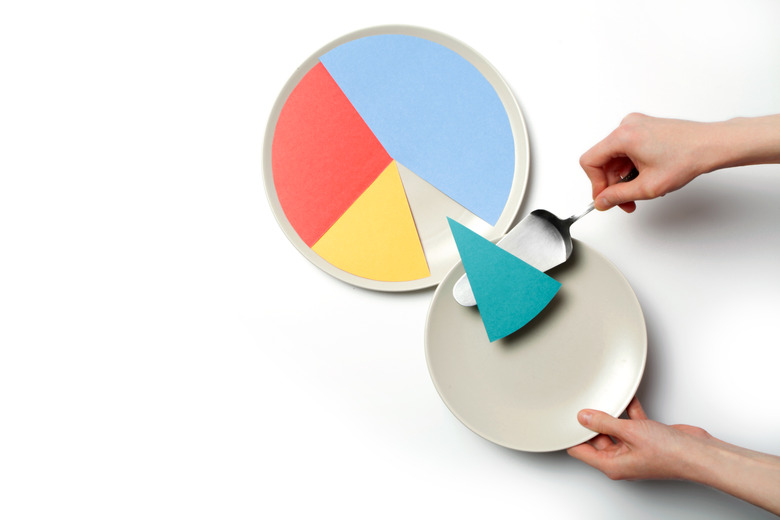How To Add A Whole Number To A Fraction
You already know what whole numbers are, even if you didn't know what the name meant: They're the numbers you used when you first started counting, beginning with 0 and then counting 1, 2, 3, 4 and so on. Fractions represent a part of a whole number. There are two ways you can add fractions and whole numbers together, but you need to follow a few basic rules when you do it.
Using Cake as an Example
Using Cake as an Example
It helps if you think of fractions and whole numbers in terms of pizzas, pies or any other delicious round thing that you can cut into pieces and eat. Think cakes: Each familiar whole number represents a whole cake. You can have 1 cake, 2 cakes, 3 cakes and so on. If you cut a cake into pieces, you've created a fraction, where the bottom number of the fraction tells you how many pieces you cut each cake into, and the top number tells you how many pieces are left.
Adding Whole Numbers and Fractions
Adding Whole Numbers and Fractions
If you think of whole numbers and fractions in terms of those cake slices, it's easy to visualize how you add whole numbers and fractions together. Say you have 2 whole cakes left on the table, plus one cake that was sliced into 6 equal pieces, but somebody ate a piece, so now there are only 5 pieces left on the plate. You can express that cut-up cake as a fraction, with the number of pieces left on top and the number of pieces originally cut on the bottom:
\(\frac{5}{6}\)
You can express the total amount of cake – 2 cakes plus 5/6 of a cake – as a mixed number, which is written as
\(2 \frac{5}{6}\)
If you have a whole number and a fraction, you can simply add them together, which results in what's called a mixed number. For example, the mixed number
\(8 \frac{3}{4}\)
is understood to mean the same thing as
\(8 + \frac{3}{4}\)
Since everybody agrees that they mean the same thing, you don't have to write out the addition symbol when you write a mixed number.
Cakes as Improper Fractions
Cakes as Improper Fractions
Sometimes you'll be asked to add whole numbers to fractions and leave them in improper fraction form instead of writing them as mixed numbers. An improper fraction is just a fraction where the top number (number of slices left) is bigger than the bottom number (the number of slices each cake was cut into). A good real-world example of this occurs if you cut two cakes into 6 pieces each, and then somebody eats 5 pieces from one cake. That means you have one whole cake left and 1/6 left from the other cake that was eaten. To give your answer completely in fraction form, you have to understand how to write that whole cake as a fraction.
Whole Numbers Can Be Written as Fractions
Whole Numbers Can Be Written as Fractions
Here's how to think of whole numbers in fraction form: If you cut a cake into 8 equal pieces and leave them all on the plate, you have 8/8 pieces of cake on the plate. In other words, the cake has been cut into pieces, but the whole thing is still there. That's what a whole number in fraction form represents. So a fraction in which the top number (the number of pieces left) is the same as the bottom number (the number of pieces you cut in the first place) is equal to a 1 whole cake, pie or whatever else you're counting.
That means
\(\frac{8}{8} = 1 \
\,\
\frac{25}{25} = 1 \
\,\
\frac{649}{649} = 1\)
and so on. It doesn't matter which number is on the top and which is on the bottom, as long as they're the same. You can also express other whole numbers as fractions; just multiply the whole number by a fraction that has the same number on top and the same number on the bottom. Just like magic, doing that turns the whole number into fraction form without changing its value, because all you did was multiply it by 1.
So to write a whole number as a fraction, multiply the whole number by a fraction that has the same number in the numerator and denominator spots. For example, if you want to write the whole number 5 as a fraction with 8 in the denominator, you'd multiply
\(5 × \frac{8}{8} = \frac{40}{8}\)
Adding Whole Numbers to Improper Fractions
Adding Whole Numbers to Improper Fractions
Now that you know how to write whole numbers as fractions, it's easy to add whole numbers to an existing fraction and leave them in improper fraction form. All you have to do is make sure the denominators – the numbers on the bottoms of the fractions – are the same. (If you tried to talk about cakes that had been cut into different-size slices it wouldn't make much sense, would it? It's the same for fractions.)
So, if you're trying to add 3 and 5/9, you'd first convert 3 into fraction form:
\(3 × \frac{9}{9} = \frac{27}{9}\)
Then, you can add the fractions 5/9 and 27/9 together. When two fractions have the same denominator, you just add the numerators straight across and write them over the same denominator. So you'd have
\(5 + 27 = 33\)
in the numerator spot and 9 in the denominator spot, or 33/9 as your final answer.
Cite This Article
MLA
Maloney, Lisa. "How To Add A Whole Number To A Fraction" sciencing.com, https://www.sciencing.com/add-whole-number-fraction-7814921/. 31 October 2020.
APA
Maloney, Lisa. (2020, October 31). How To Add A Whole Number To A Fraction. sciencing.com. Retrieved from https://www.sciencing.com/add-whole-number-fraction-7814921/
Chicago
Maloney, Lisa. How To Add A Whole Number To A Fraction last modified March 24, 2022. https://www.sciencing.com/add-whole-number-fraction-7814921/
